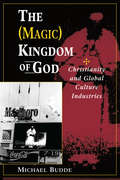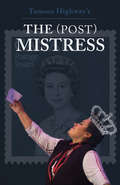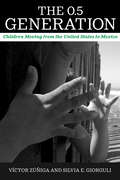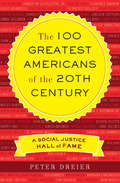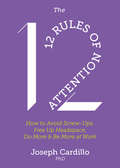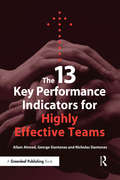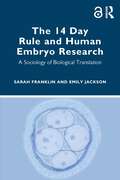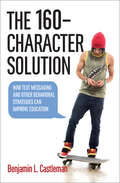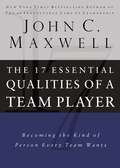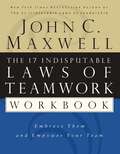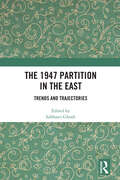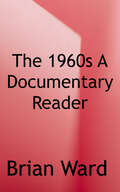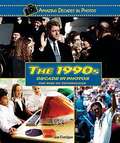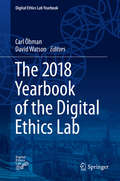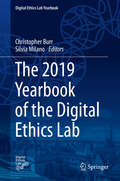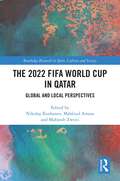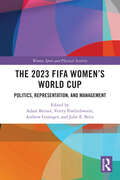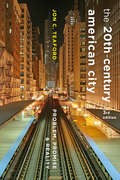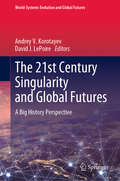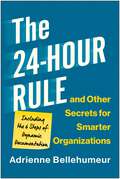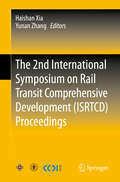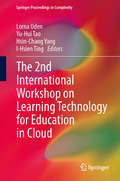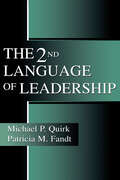- Table View
- List View
The (Magic) Kingdom Of God: Christianity And Global Culture Industries
by Michael L BuddeIn The (Magic) Kingdom of God, Michael Budde offers a multidisciplinary analysis of the “global culture industries”-increasingly powerful, centralized corporate conglomerates in television, advertising, marketing, movies, and the like-and their impact on Christian churches in industrialized countries. Utilizing ideas from contemporary and classical
The (Post) Mistress
by Tomson HighwayMarie-Louise Painchaud has worked for thirty-five years as post mistress at the post office in Lovely, a francophone Canadian village where she has come to know every client whose mail she handles. The (Post) Mistress is a rollicking, emotional rollercoaster-ride in the form of a one-woman musical, with elements of jazz, Berlin cabaret, French café music, and Brazilian samba.
The 0.5 Generation: Children Moving from the United States to Mexico
by Dr. Víctor Zúñiga Dr. Silvia E. GiorguliAt the beginning of the twenty-first century, a generation of children crossed the border from the United States to begin their lives anew in Mexico. While all were international migrants, their roots spread far and wide. Some were migrant returnees born in Mexico; others had only ever known a life in the United States. Distinguishing returnees from new arrivals seems simple, but defining these youths' affiliations in their new homes in Mexico is much more complex and yields new insights that enrich our contemporary understanding of inclusion and belonging. This book is the product of twenty-five years' worth of fruitful interdisciplinary dialogue and research on these children's trajectories, tracing their journeys and studying integration—or lack thereof—into Mexican society and institutions.
The 10 Principles of Open Business
by Jamie Burke David CushmanThe 10 Principles of Open Business is a practical guide to organizational design for the Twenty-First Century. Using case studies, the authors define the 10 principles of open business that organisations must adopt to both survive and thrive, and provide a practical method to assess the reader's own organization.
The 100 Greatest Americans of the 20th Century: A Social Justice Hall of Fame
by Peter DreierA hundred years ago, any soapbox orator who called for womenOCOs suffrage, laws protecting the environment, an end to lynching, or a federal minimum wage was considered a utopian dreamer or a dangerous socialist. Now we take these ideas for granted? because the radical ideas of one generation are often the common sense of the next. We all stand on the shoulders of earlier generations of radicals and reformers who challenged the status quo of their day. Unfortunately, most Americans know little of this progressive history. It isnOCOt taught in most high schools. You canOCOt find it on the major television networks. In popular media, the most persistent interpreter of AmericaOCOs radical past is Glenn Beck, who teaches viewers a wildly inaccurate history of unions, civil rights, and the American Left. "The 100 Greatest Americans of the 20th Century," a colorful and witty history of the most influential progressive leaders of the twentieth century and beyond, is the perfect antidote.
The 12 Rules of Attention: How to Avoid Screw-Ups, Free Up Headspace, Do More and Be More At Work
by Joseph CardilloDo you feel like you're "crushing it?" How productive, happy and fulfilled do you feel each day at your job? You might ask what attention has to do with it. The answer may help clear up and fix a wide range of ongoing workplace concerns including workplace error. Simply put, attention is connected to every single thing you think, feel and do at work and elsewhere. It's almost impossible to imagine, but by the end of this book you'll not only understand how this is so, but you will be tapping into your attentional system and regulating it to your highest advantage. The 12-Rules of Attention will help you train your attention to sharp, accurate, high definition...and keep it there. You'll learn: How to use the entire attentional system, beyond just focus (which is only one part) How to avoid fading out Awareness, mindfulness and attention are not the same thing and how and when to employ each A process to relieve data overflow, internal and external distraction How to use "in a glance" mental capacity to "catch" more desired detail How to regulate the brain's automatic, high-speed attention triggers and use them to your advantage
The 13 Key Performance Indicators for Highly Effective Teams
by Allam Ahmed George Siantonas Nicholas SiantonasAn organisation's most important asset is its people. And critical to an organisation's success is the extent to which its people interact effectively – both with each other as team members and with the wider organisation. This is why managing teams has become a key area for a growing number of organisations around the world. While many organisations are world-class at managing their materials and machinery, they fall short in managing the human side of their activities.This book outlines the challenges faced by both team leaders and team members in 21st-century workplaces. It proposes 13 key performance or "team health" indicators for highly effective teams based on research data collected from a large range of industry sectors, team sizes and organisations in the UK. It contributes to the understanding of the nature and functioning of team cohesiveness by describing teamwork as a multi-component variable and identifying the factors that impact on teams and the implications of teamwork for organisations.The book sets out to aid organisations by introducing a Team Performance Diagnostic (TPD) tool. The TPD enables organisations to gain an accurate and detailed insight into the real-time performance of their teams, helps team managers to understand the underlying 'people' issues within the team and how to reach higher levels of team performance quickly. The TPD has been widely used in major multinationals and the UK public sector to pinpoint hard-to-find opportunities to achieve rapid improvements.The research suggests that the use of TPD contributes to more free-flowing feedback both within the team and in the organisation as a whole, and that successful teams are indicative of a healthy organisational culture.This book is an essential guide for senior managers and policy-makers dealing with team effectiveness, and will be highly useful for students of business and management.
The 14 Day Rule and Human Embryo Research: A Sociology of Biological Translation
by Sarah Franklin Emily JacksonThis assessment of Britain’s influential 14 day rule governing embryo research explores how and why it became the de facto global standard for research into human fertilisation and embryology, arguing that its influence and stability offers valuable lessons for successful biological translation.One of the most important features of the 14 day rule, the authors claim, is its reliance on sociological as well as ethical, legislative, regulatory and scientific principles. The careful integration of social expectations and perceptions, as well as sociological definitions of the law and morality, into the development of a robust legislative infrastructure of ‘human fertilisation and embryology’, enabled what has come to be known as the Warnock Consensus – a solid and enduring public acceptance that has enabled successive parliamentary approval for controversial areas of scientific research in the UK, such as stem cell research and mitochondrial donation, for over 30 years. These important sociological insights are increasingly relevant to new biotranslational challenges such as human germline gene editing and the use of AI assisted technologies in human reproduction. As the legislation around the 14 day rule begins to be reviewed worldwide, the important lessons we can learn from its global and enduring significance will apply not only to future legislation governing embryo research, but to the future of biological translation more widely.An important volume for those interested in reproductive studies, biogovernance and biological translation, it is suitable for researchers, clinicians and students in medicine, biosciences, sociology, and science and technology studies.
The 160-Character Solution: How Text Messaging and Other Behavioral Strategies Can Improve Education
by Benjamin L. CastlemanA fascinating study that brings the power of behavioral economics to how schools work, how students learn, and how we can help them succeed.For decades schools have invested substantial resources in boosting educational outcomes for disadvantaged students, but those investments have not always generated positive outcomes. Although many communities have expanded school choice, for example, families often choose to keep their children in failing schools. And while the federal government has increased the size of Pell Grants, many college-bound students who would be eligible for aid never apply. Then there is the troubling trend of "summer melt," in which up to 40 percent of high school graduates who have been accepted to college, mostly from underserved communities, fail to show up for the fall semester. In The 160-Character Solution, Benjamin L. Castleman shows how insights from behavioral economics—the study of how social, cognitive, and emotional factors affect our decisions—can be leveraged to help students complete assignments, perform to their full potential on tests, and choose schools and colleges where they are well positioned for success. By employing behavioral strategies or "nudges," Castleman shows, administrators, teachers, and parents can dramatically improve educational outcomes from preschool to college.Castleman applies the science of decision making to explain why inequalities persist at various stages in education and to identify innovative solutions to improve students’ academic achievement and attainment. By focusing on behavioral changes, Castleman demonstrates that small changes in how we ask questions, design applications, and tailor reminders can have remarkable impacts on student and school success.
The 17 Essential Qualities of a Team Player: Becoming the Kind of Person Every Team Wants
by John C. MaxwellJohn C. Maxwell breaks down the personal characteristics necessary for becoming an effective team player.Leadership expert John C. Maxwell follows his bestselling The 17 Indisputable Laws of Teamwork with this powerfully succinct companion book. Stating that great team players are developed from the inside out, Maxwell identifies the seventeen qualities that make up an in-demand team player while outlining how to embody those qualities.In The 17 Essential Qualities of a Team Player, Maxwell outlines the successes of team players who have been:Intentional – making every action count toward a long-term goalRelational – focused on othersSelfless – willing to take a subordinate role for the sake of the teamTenacious – hardworking and optimistic in the face of setbacksThis instructional resource shows how these qualities, among many others, impact the team and its success. If you want to have a better team, you have to develop better players.The 17 Essential Qualities of a Team Player is not feel-good platitudes and abstract thinking, but concrete actions designed to improve the value of every team player.
The 17 Indisputable Laws of Teamwork Workbook: Embrace Them and Empower Your Team
by John C. MaxwellThe 17 Indisputable Laws of Teamwork has quickly become one of John Maxwell's bestselling books on leadership. Now, in this companion workbook, Dr. Maxwell provides a tool every person can use to adapt the 17 Laws to leadership at home, work, and church.
The 1947 Partition in The East: Trends and Trajectories
by Subhasri GhoshThis book explores the experiences of people affected by the Partition of British India and princely states in 1947 through first-person accounts, memoirs, archival material, literature, and cinema. It focuses on the displacement, violence and trauma of the people affected and interrogates the interrelationships between nationalism, temporality, religion, and citizenship. The authors examine the mass migrations triggered by the 1947 Partition, amidst nationalist posturing, religious violence, and debates on crucial issues of refugee rehabilitation and redistribution of land and resources. It focuses on the drawing of the borders and the ruptures in the socio-cultural bonds within regions and communities brought on by demographic changes, violence, and displacement. The volume reflects on the significant mark left by the event on the socio-political sensibilities of various communities, and the questions of identity and citizenship. It also studies the effects of Partition on the politics of Bangladesh and India’s east and northeast states, specifically Bengal, Assam and Tripura. A significant addition to the existing corpus on Partition historiography, this book will be of interest to modern Indian history, partition studies, border studies, sociology, refugee and migration studies, cultural studies, literature, post-colonial studies and South Asian studies, particularly those concerned with Bengal, Northeast India and Bangladesh.
The 1960s: A Documentary Reader (Uncovering The Past: Documentary Readers In American History Ser. #1.0)
by Brian WardDrawn from a wide range of perspectives and showcasing a variety of primary source materials, Brian Ward's The 1960s: A Documentary Reader highlights the most important themes of the era. Supplies students with over 50 primary documents on the turbulent period of the 1960s in the United States Includes speeches, court decisions, acts of Congress, secret memos, song lyrics, cartoons, photographs, news reports, advertisements, and first-hand testimony A comprehensive introduction, document headnotes, and questions at the end of each chapter are designed to encourage students to engage with the material critically
The 1990s Decade in Photos: The Rise of Technology (Amazing Decades in Photos)
by Jim CorriganMiddle school readers will find out about the important world, national, and cultural developments of the decade 1990-1999.
The 2018 Yearbook of the Digital Ethics Lab (Digital Ethics Lab Yearbook #1)
by David Watson Carl ÖhmanThis book explores a wide range of topics in digital ethics. It features 11 chapters that analyze the opportunities and the ethical challenges posed by digital innovation, delineate new approaches to solve them, and offer concrete guidance to harness the potential for good of digital technologies. The contributors are all members of the Digital Ethics Lab (the DELab), a research environment that draws on a wide range of academic traditions.The chapters highlight the inherently multidisciplinary nature of the subject, which cannot be separated from the epistemological foundations of the technologies themselves or the political implications of the requisite reforms. Coverage illustrates the importance of expert knowledge in the project of designing new reforms and political systems for the digital age. The contributions also show how this task requires a deep self-understanding of who we are as individuals and as a species.The questions raised here have ancient -- perhaps even timeless -- roots. The phenomena they address may be new. But, the contributors examine the fundamental concepts that undergird them: good and evil, justice and truth. Indeed, every epoch has its great challenges. The role of philosophy must be to redefine the meaning of these concepts in light of the particular challenges it faces. This is true also for the digital age. This book takes an important step towards redefining and re-implementing fundamental ethical concepts to this new era.
The 2019 Yearbook of the Digital Ethics Lab (Digital Ethics Lab Yearbook)
by Christopher Burr Silvia MilanoThis edited volume presents an overview of cutting-edge research areas within digital ethics as defined by the Digital Ethics Lab of the University of Oxford. It identifies new challenges and opportunities of influence in setting the research agenda in the field.The yearbook presents research on the following topics: conceptual metaphor theory, cybersecurity governance, cyber conflicts, anthropomorphism in AI, digital technologies for mental healthcare, data ethics in the asylum process, AI’s legitimacy and democratic deficit, digital afterlife industry, automatic prayer bots, foresight analysis and the future of AI. This volume appeals to students, researchers and professionals.
The 2022 FIFA World Cup in Qatar: Global and Local Perspectives (Routledge Research in Sport, Culture and Society)
by Mahfoud Amara Mahjoob Zweiri Nikolay KozhanovThis book offers an in‑depth analysis of the 2022 FIFA World Cup in Qatar. The first World Cup to be held in the Middle East, this was a unique sporting mega‑event, and this book explores its wider significance across political, socio‑cultural, economic, organisational and historical dimensions.Featuring the work of an international team of researchers, this book includes local and regional perspectives on the Qatar World Cup as well as views from beyond the Middle East. It covers the development phase, including the bidding process, as well as the tournament itself, exploring key contemporary issues in sport and event studies such as sports diplomacy and the geopolitics of sport, post‑colonial narratives, event legacies and community development, media framing, inclusive access, sport policy and governance, and mega‑events and human rights.Making sense of the world’s biggest sports event in an era in which sport has become a source of soft power for states around the world, this book is fascinating reading for anybody with an interest in the politics of sport, sport business and management, sport for development, event studies or the relationships between sport and wider society.
The 2023 FIFA Women's World Cup: Politics, Representation, and Management (Women, Sport and Physical Activity)
by Adam Beissel, Verity Postlethwaite, Andrew Grainger, and Julie E. BriceThis book offers a critical examination of the 2023 Fédération Internationale de Football Association (FIFA) Women’s World Cup, being held in Australia and Aotearoa New Zealand. Drawing on perspectives from sociology, history, political science, and management, it sheds new light on the development of women’s soccer and on women’s sport more broadly. This book examines the politics of the build-up to the tournament, including the bidding process, as well as how the tournament has been represented in the media, the governance structures of the tournament itself, and policy proposals designed to leave an enduring legacy for women and girls in sport. The 2023 FIFA Women’s World Cup is the first Women’s World Cup to be held in the Southern Hemisphere and the first to be held with an expanded 32-team format. This book shows why the 2023 FIFA Women’s World Cup represents a unique opportunity to enhance our understanding of women’s football, gender-oriented sport development initiatives and strategies, national sport policy and programming, and the management of international sporting events. This book is fascinating reading for any student, researcher, or practitioner with an interest in sport development, sport management, sport policy, sport sociology, event management, gender studies, political science, or the relationship between sport and wider society.
The 20th-Century American City: Problem, Promise & Reality (The American Moment)
by Jon C. TeafordAn updated edition of the essential text from “a respected urban historian” (Annals of Iowa).Throughout the twentieth century, the city was deemed a problematic space, one that Americans urgently needed to improve. Although cities from New York to Los Angeles served as grand monuments to wealth and enterprise, they also reflected the social and economic fragmentation of the nation. Race, ethnicity, and class splintered the metropolis both literally and figuratively, thwarting efforts to create a harmonious whole. The urban landscape revealed what was right—and wrong—with both the country and its citizens’ way of life.In this thoroughly revised edition of his highly acclaimed book, Jon C. Teaford updates the story of urban America by expanding his discussion to cover the end of the twentieth century and the first years of the next millennium. A new chapter on urban revival initiatives at the close of the century focuses on the fight over suburban sprawl as well as the mixed success of reimagining historic urban cores as hip new residential and cultural hubs. The book also explores the effects of the late-century immigration boom from Latin America and Asia, which has complicated the metropolitan ethnic portrait.Drawing on wide-ranging primary and secondary sources, Teaford describes the complex social, political, economic, and physical development of US urban areas over the course of the long twentieth century. Touching on aging central cities, technoburbs, and the ongoing conflict between inner-city poverty and urban boosterism, The Twentieth-Century American City offers a broad, accessible overview of America’s persistent struggle for a better city.
The 21st Century Nonprofit: Managing in the Age of Governance (2nd edition)
by Paul B. Firstenberg Rick SchoffGovernance is often thought of as connoting a governmental or institutional response to corporate wrongdoing. This is undoubtedly a consequence of the corporate scandals at the turn of the century and, in response, the passage of national legislation, new security exchange rules, and the actions of the Securities and Exchange Commission and state attorneys general.
The 21st Century Singularity and Global Futures: A Big History Perspective (World-Systems Evolution and Global Futures)
by Andrey V. Korotayev David J. LePoireThis book introduces a 'Big History' perspective to understand the acceleration of social, technological and economic trends towards a near-term singularity, marking a radical turning point in the evolution of our planet. It traces the emergence of accelerating innovation rates through global history and highlights major historical transformations throughout the evolution of life, humans, and civilization. The authors pursue an interdisciplinary approach, also drawing on concepts from physics and evolutionary biology, to offer potential models of the underlying mechanisms driving this acceleration, along with potential clues on how it might progress. The contributions gathered here are divided into five parts, the first of which studies historical mega-trends in relation to a variety of aspects including technology, population, energy, and information. The second part is dedicated to a variety of models that can help understand the potential mechanisms, and support extrapolation. In turn, the third part explores various potential future scenarios, along with the paths and decisions that are required. The fourth part presents philosophical perspectives on the potential deeper meaning and implications of the trend towards singularity, while the fifth and last part discusses the implications of the Search for Extraterrestrial Intelligence (SETI). Given its scope, the book will appeal to scholars from various disciplines interested in historical trends, technological change and evolutionary processes.
The 24-Hour Rule and Other Secrets for Smarter Organizations: Including the 6 Steps of Dynamic Documentation
by Adrienne BellehumeurHow do we change our focus from what we KNOW to what we DO with what we know? Convert your abstract ideas, plans, and proprietary knowledge into purposeful action with an innovative six-step approach proven to solve your business problems and strengthen your workflow. It&’s one thing to have a great idea—but it&’s an entirely different thing to actually bring that idea to life. Consultant Adrienne Bellehumeur&’s purposeful practices are your key to capturing our collective brains&’ bounty—and to pull the most power from even the simplest of actions. In The 24-Hour Rule and Other Secrets for Smarter Organizations, Bellehumeur draws on the fields of productivity, knowledge management, and design thinking to form what will soon become your and your team&’s greatest work superpower. At the heart of Bellehumeur&’s six-steps of Dynamic Documentation is the &“24-Hour Rule,&” a reminder that actionable items—like to-dos, deadlines, feedback, and observations—need to be written down and shared with others. Without embracing documentation—and other memorable secrets like &“The Skill Stack Solution&” and &“The Groundhog Trap,&”—our greatest plans and hoped-for solutions will easily slide into oblivion. What&’s more, Bellehumeur&’s Dynamic Documentation is a &“zen&” approach to information management, making documentation accessible, doable, and even appealing. Not only will this refreshingly simple guide equip you with an array of practical tools, it will also bring real joy to your everyday work activities.
The 2nd International Symposium on Rail Transit Comprehensive Development (ISRTCD) Proceedings
by Haishan Xia Yunan ZhangWith the increasing sophistication of urban rail networks, the combined effects of rail transit on urban development are more and more complex and in-depth, and large-scale rail transit construction and operation have placed new demands on planning, construction, investment and financing. This main aim of these proceedings is to study and explore theoretical progress, methodological innovation and lessons learned in aspects of the planning stage, urban planning, architectural design, development and construction, safety systems, management support, etc. involved in the process of comprehensive utilization along urban rail transit lines and in the development and utilization of the surrounding land, in order to provide a platform for decision-makers and researchers involved in urban rail transit construction, urban construction and development.
The 2nd International Workshop on Learning Technology for Education in Cloud
by Lorna Uden I-Hsien Ting Hsin-Chang Yang Yu-Hui TaoProceedings from the 2013 LTEC conference in Kaohsiung, Taiwan. The papers examine diverse aspects of Learning Technology for Education in Cloud environments, including social, technical and infrastructure implications. Also addressed is the question of how cloud computing can be used to design applications to support real time on demand learning using technologies. The workshop proceedings provide opportunities for delegates to discuss the latest research in TEL (Technology Enhanced Learning) and its impacts for learners and institutions, using cloud technologies.
The 2nd Language of Leadership
by Michael P. Quirk Patricia M. FandtThis book focuses on the behavioral and personality areas that can be used to strengthen one's skills and to make wise decisions about when and how to lead. It was written for the working professional who wants to learn what he or she can do by working with their personality to become more satisfied with and masterful in their leadership roles. Good leaders have learned to succeed over time by acquiring the needed range of personal skills, much like one learns a second language. Geared for entry and mid-term leaders, this book is an empirically based training guide to acquire knowledge and implement a plan to help increase one's leadership skills. Within the framework of 10 chapters, this book: * promotes a shared recognition of the role that personality plays in leadership by reviewing a case study of representative leadership situation that both identifies familiar personal struggles and organizational changes; * offers a way of thinking about how personality in general and the Big 5 in particular fills in the gaps and connects the pieces when it comes to how people become effective leaders; * illustrates how--within the Big 5 framework--to use the 2nd language approach to leverage natural personality strengths and manage weaknesses in an effort to build greater leadership effectiveness; * makes available 2nd language tools including effective intervention strategies and goal setting techniques based on enabling philosophies to understand what makes this approach accessible and practical to use; and * reassures that most leadership failures are reversible and that through using the 2nd language approach, these inevitable and sometimes necessary setbacks afford clarity about how to use your style to the best advantage.
